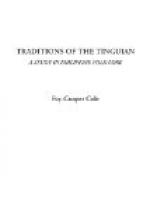IX. Gawigawen [male]. A giant who owns the orange trees of Adasin.
X. Giambolan [male]. A ten-headed giant.
XI. Gaygayoma. A star maiden who marries
Aponitolau. The daughter of
Bagbagak [male], a big star,—and Sinag
[female], the moon—.
XII. Tabyayen. Son of Aponitolau and Gaygayoma. Half brother of Kanag.
XIII. Kabkabaga-an. A powerful female spirit
who falls in love with
Aponitolau.
XIV. Asibowan. The maiden of Gegenawan,
who is related to the spirit
Kaboniyan. The mistress of Aponitolau.
In consequence of modern rationalism there is a tendency on the part of a considerable number of the Tinguian to consider these tales purely as stories and the characters as fictitious, but the mass of the people hold them to be true and speak of the actors as “the people who lived in the first times.” For the present we shall take their point of view and shall try to reconstruct the life in “the first times” as it appears in the tales.
The principal actors live in Kadalayapan and Kaodanan, [6] towns which our chief story teller—when trying to explain the desire of Kanag to go down and get fruit—assures us were somewhere in the air, above the earth (p. 141). [7] At other times these places are referred to as Sudipan—the term by which spirits are supposed to call the present earth—while the actors are referred to as Ipogau—the spirit name for Tinguian. Whatever its location it was a place much like the present home of this people. The sky, the chief abode of spirits and celestial bodies, was above the land, and the heroes of the tales are pictured as ascending to visit the upper realms. The trees, plants, and animals were for the most part those known to-day. The ocean appears to have been well known, while mention is made of some places in Luzon, such as Dagopan and San Fernando in Pangasinan with which the people of to-day are not at all familiar (p. 89, 168).
We learn that each village is situated near to a river or waterway by the banks of which shallow wells are dug, and there we find the women gathering under the shade of the trees, dipping up water to be carried to their homes, washing and combing their hair, and taking their baths (p. 48). They seldom go singly, for enemies are apt to be near, and unless several are in the company it will be impossible to spread the alarm and secure help in case of attack (p. 43).
Leading up from the spring to the village are bamboo poles on which the heads of enemies are displayed (p. 43). In cases where the warriors have been especially successful these trophies may surround the whole settlement (p. 76). About the town is a defensive wall, generally of bamboo, but in some cases made up entirely of gigantic snakes (p. 43). Within this inclosure are many houses. The bamboo floors are raised high above the ground, while the thatching is of grass. Ladders lead up to little porches, from which doors open into the dwellings. At least part of the houses have a cooking room in addition to that used by the family, while structures containing a ninth room are several times mentioned (pp. 43, 52, 85).




